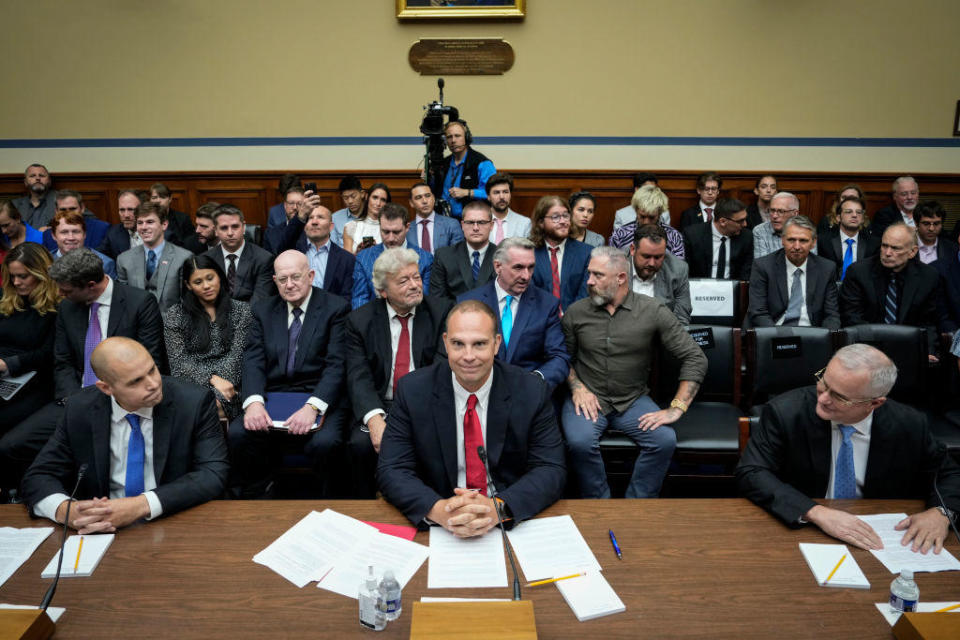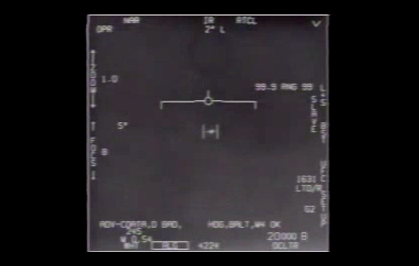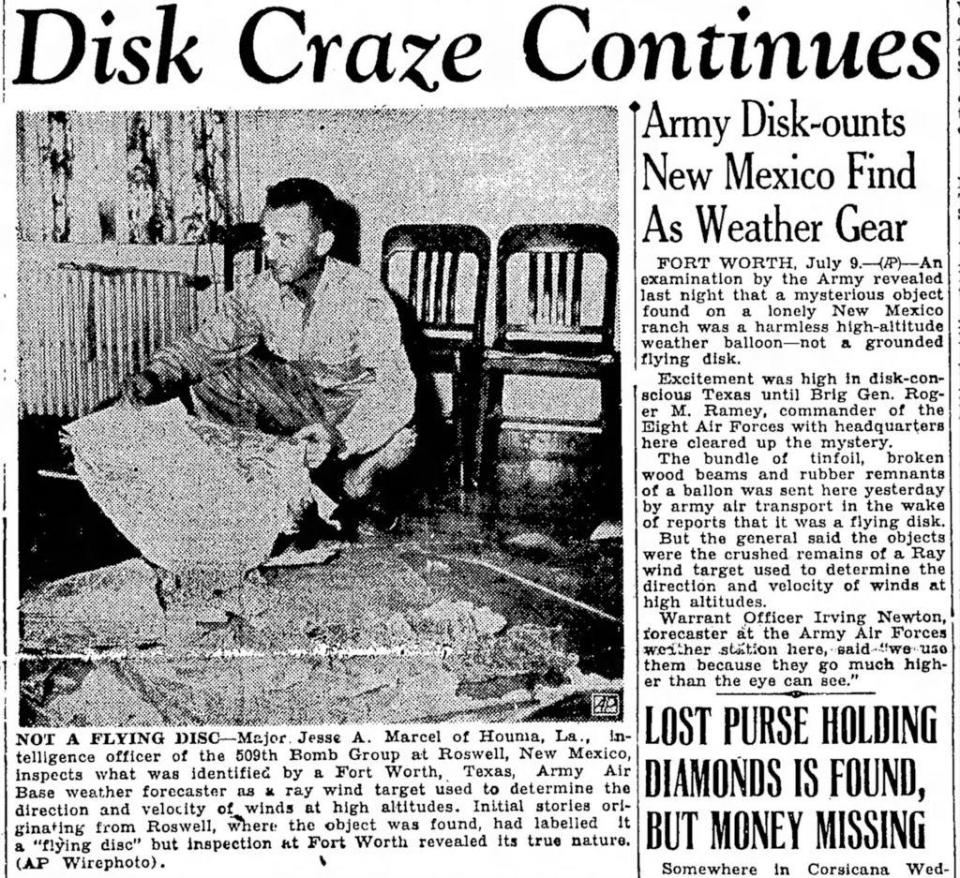What are UAPs, and why do UFOs have a new name?
Washington — Members of Congress heard stunning testimony during a hearing July 27 with a former intelligence officer-turned-whistleblower and two pilots about their experiences with strange, seemingly inexplicable objects that hundreds of pilots have reported encountering in recent years.
The hearing, held by a House subcommittee, focused on so-called UAP, the formal government name for objects that had previously been known as UFOs. The witnesses shined a light on an issue that has attracted renewed interest over the past several years, but many Americans are turning their attention to the phenomena for the first time.
Separately, NASA convened a group of 16 experts to review how data about UAPs is collected across the government and private sector, and issue recommendations for how the space agency can contribute to investigations into their origins. Formally known as the Unidentified Anomalous Phenomena Independent Study, the group released its final report on Sept. 14. The group found no evidence that UAPs are "extraterrestrial," but said a small subset of reported encounters still defy explanation.
Here are some common questions about UAP and what we know about them.
What does UAP stand for?
UAP stands for "unidentified anomalous phenomena," a catch-all term to describe objects detected in the air, sea and space that defy easy explanation.
The acronym stood for "unidentified aerial phenomena" until December 2022, when the Pentagon updated its terminology to encompass "submerged and trans-medium objects," as one official put it at the time. NASA and other agencies soon followed suit.
What are UAPs?
By definition, unidentified anomalous phenomena are just that — unidentified. But generally the term refers to objects spotted by pilots or detected by sensors that cannot be immediately explained.
Hundreds of military and commercial pilots have reported UAP encounters. The Pentagon has released several videos in recent years showing some of the objects. Many end up having innocent explanations —they turn out to be weather balloons, drones or small aircraft— while others remain shrouded in mystery.
David Grusch, the ex-intelligence officer, told lawmakers at Wednesday's hearing that he had learned of "a multi-decade UAP crash retrieval and reverse-engineering program" by the government while he was working at a Pentagon office dedicated to investigating the encounters. A spokeswoman for the office said it had no evidence of such a program.
The two other witnesses, David Fravor and Ryan Graves, told lawmakers about their firsthand experience with the mysterious objects while piloting military aircraft. Graves said the incidents were "not rare or isolated," and that "the American people deserve to know what is happening in our skies."

The exact nature of the objects vary, but the most noteworthy incidents that have been made public typically feature spherical or oval-shaped objects traveling at high speeds with no apparent means of propulsion. Pilots report that the objects appear smooth, with no seams or rivets found on conventional aircraft. Many say they fly in ways that seemingly defy physics.
Fravor recounted his experience with a UAP in his congressional testimony. He first came forward in 2017 in an interview with The New York Times, which published a series of stories now credited with bringing the issue to light and pushing the government to collect data information about UAPs in a more systematic way.
In 2004, Fravor was flying an F-18 fighter jet on a training mission with another pilot off the coast of San Diego when they were ordered to investigate an object. For weeks, Navy sensors had been detecting unknown objects that would descend from 80,000 feet to 20,000 feet, where they would remain for hours before zooming back skyward.
When Fravor and his fellow pilot reached the area where the object was detected, they spotted a "small, white Tic-Tac shaped object" about 40 feet long hovering above the water, with white water churning underneath in otherwise calm seas. It had no wings or indication of how it was moving. Fravor descended to get a better look, and the object began climbing to about 12,000 feet above the water. As he came closer, the object "rapidly accelerated and disappeared right in front of our aircraft," as he said at the hearing. Less than a minute later, Navy sensors detected it 60 miles away.
The object "was far superior in performance" to Fravor's fighter jet and "did not operate with any of the known aerodynamic principles that we expect for objects that fly in our atmosphere," he said. Fravor and the second pilot returned to their aircraft carrier and mentioned the encounter to other pilots who were getting ready to take off. They tracked down the object and one captured footage of it using an advanced camera, in what came to be known as the "Tic Tac" video.

While tantalizing videos of seemingly inexplicable objects attract the most attention, the military has said that most UAP reports turn out to have innocuous explanations. In 2021, Congress ordered the Pentagon to establish an office in coordination with the intelligence community to investigate the incidents, which it did last year.
The office, known as the All-domain Anomaly Resolution Office, or AARO, is led by Sean Kirkpatrick. He told a Senate panel in April that "only a very small percentage of UAP reports display signatures that could reasonably be described as 'anomalous.'"
"While a large number of cases in our holdings remain technically unresolved, this is primarily due to a lack of data associated with these cases," he said. "Without sufficient data, we are unable to reach defendable conclusions that meet the high scientific standards we set for resolution, and I will not close a case that we cannot defend the conclusions of."
Kirkpatrick told a NASA study group in May that his office has collected more than 800 UAP reports, and that between 2% and 5% of those incidents end up being "truly anomalous." He said the office is preparing another report on its work that will be released next month with updated figures.
He has also said that AARO "has found no credible evidence thus far of extraterrestrial activity, off-world technology, or objects that defy the known laws of physics."
Why don't we call them UFOs anymore?
The objects now known as UAPs used to be called unidentified flying objects, or UFOs, a term that remains in widespread use today.
The Air Force coined the phrase "UFO" in 1952, five years after a private pilot named Kenneth Arnold reported seeing flying objects in the sky. His account in June 1947 attracted enormous media coverage and kicked off a craze about flying discs and saucers, with hundreds of reports emerging soon after. Weeks later, reports quickly spread about a flying disc that had supposedly crashed near Roswell, New Mexico. The military soon claimed the object was part of a weather balloon system.

UFOs became a cultural phenomenon over the ensuing decades, with depictions of alien creatures and spacecraft visiting Earth emerging as a staple of science fiction books, movies and TV shows. The fictional series "The X-Files" in the 1990s and early 2000s depicted secret government efforts to cover up knowledge of extraterrestrial life and the supernatural, arguably the high water mark of depictions of UFOs in popular culture.
The term "unidentified aerial phenomena" has been in use among UFO researchers for years. A review of news archives shows the term was first used in the press in 1987, when outlets covered an "International Symposium on Unidentified Aerial Phenomena," a gathering of self-described UFOlogists marking the 40-year anniversary of the Roswell incident.
But the recent official shift from "UFO" to "UAP" began to take hold in 2020, when the Pentagon established the Navy-led "UAP Task Force" to investigate reports. The group was the predecessor of the AARO.
"UFOs" still carried an association with a strain of conspiratorial and paranoid thinking that discouraged many pilots from coming forward with their own experiences, fearing a negative impact on their careers or reputations. Graves, the other fighter pilot who testified before Congress, told lawmakers that "the stigma attached to UAP is real and powerful and challenges national security."
"It silences commercial pilots who fear professional repercussions, discourages witnesses, and is only compounded by recent government claims questioning the credibility of eyewitness testimony," he said.
What do experts say about UAP sightings?
While the exact nature of UAPs continues to elude the scientific community, researchers and experts have ramped up efforts to collect improved data about the objects, in the hopes of gaining a better understanding of what they may be.
Last year, NASA convened a 16-member panel of prominent experts to examine the government's data-collection efforts. It held its first and only public meeting in May and issued its findings in September.
"The top takeaway from the study is that there is a lot more to learn," NASA Administrator Bill Nelson said at a briefing about the findings. "The NASA independent study team did not find any evidence that UAP have an extraterrestrial origin. But we don't know what these UAP are."
Unlike the AARO, which has access to classified information from across the government, the NASA group relied on unclassified material, with the goal of improving coordination across the public and private sector to collect better information about UAPs. Members stressed the need for higher-quality data to get a better understanding of what UAPs might be, and said NASA should take a more prominent role in leading the scientific inquiry into the encounters.
The NASA report, which relied on unclassified information, noted that a small subset of UAP incidents "cannot be immediately identified as known human-made or natural phenomena." Understanding these incidents "will require new and robust data acquisition methods, advanced analysis techniques, a systematic reporting framework and reducing reporting stigma," the report said.
But the group said there is a high bar for claiming that the objects have an otherworldly origin.
"[I]n the search for life beyond Earth, extraterrestrial life itself must be the hypothesis of last resort — the answer we turn to only after ruling out all other possibilities. As Sherlock Holmes said, 'Once you eliminate the impossible, whatever remains, no matter how improbable, must be the truth,'" the report said. "To date, in the peer-reviewed scientific literature, there is no conclusive evidence suggesting an extraterrestrial origin for UAP. When it comes to UAP, the challenge we have is that the data needed to explain these anomalous sightings often do not exist."
Hunter Biden charged with lying about using illegal drugs while buying gun
Hunter Biden indicted on federal gun-related charges
Why Trump, co-defendants won't all be tried together in Georgia election subversion case
